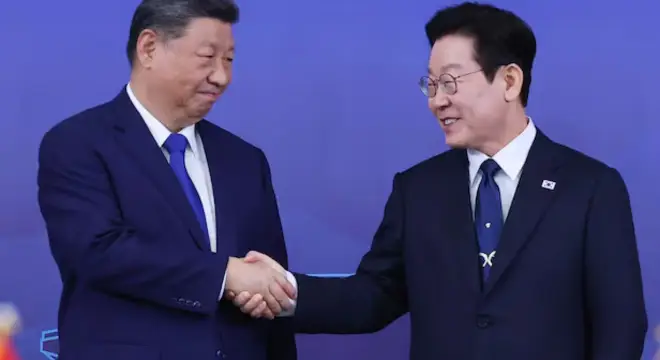What happens when two powerful neighbors — bound by history, divided by alliances — finally sit face to face after more than a decade?
That’s exactly what the world saw this week during the Lee Jae Myung Xi Jinping meeting in Gyeongju, marking China’s President Xi Jinping’s first visit to South Korea in 11 years.
But why was this meeting so important?
And can it really reshape the tense ties between Seoul, Beijing, and Pyongyang?
Let’s start from the beginning.
Setting the Stage: Why Everyone Was Watching
The timing of Xi’s visit couldn’t have been more dramatic.
The world’s attention was already on the APEC Leaders’ Summit in South Korea, where U.S. President Donald Trump had just sealed a trade deal with Lee before flying home early.
That left the spotlight wide open for Xi Jinping — who, in his signature calm and strategic style, stepped in to reassert China’s influence in the region.
Lee Jae Myung, who became president in June after a turbulent election, had made one promise clear from the start — he wanted to balance South Korea’s ties between the U.S. and China while keeping hopes alive for peace with North Korea.
And this meeting was his biggest diplomatic test yet.
A Handshake 11 Years in the Making
The visuals said it all.
Xi arrived at the Gyeongju National Museum, greeted by South Korea’s military honor guard and autumn leaves swirling in the air.
As the two leaders shook hands — one leading the world’s second-largest economy, the other steering one of Asia’s most vibrant democracies — it wasn’t just a photo-op.
It was a message: “We’re ready to talk again.”
But Why Now?
That’s the million-dollar question.
Why did Xi decide to visit South Korea now, after more than a decade of frosty ties?
The answer lies in geopolitical timing.
Over the past few years, Seoul and Beijing drifted apart.
The U.S.-China rivalry deepened.
And the deployment of the THAAD missile defense system in South Korea had triggered Chinese backlash — leading to sanctions, boycotts, and a collapse in Korean car sales in China.
But things are changing.
Lee Jae Myung isn’t looking to pick sides.
He wants South Korea to be a bridge, not a battlefield between the two global powers.
And Xi? He wants to rebuild influence in Seoul at a time when both Japan and the U.S. are strengthening military partnerships around China’s borders.
North Korea: The Toughest Part of the Puzzle
Now here’s where things get even more interesting.
Lee’s biggest hope from this meeting was China’s help in restarting talks with North Korea.
He believes that only through dialogue — not pressure — can the Korean Peninsula move toward peace.
Xi, meanwhile, remains North Korea’s closest ally, both economically and politically. In September, he even hosted Kim Jong Un and Vladimir Putin together at a military parade in Beijing.
So, Lee’s message was clear:
“Let’s use this moment — your connection with Pyongyang and our desire for peace — to reopen dialogue.”
But hours before the summit, North Korea issued a statement, calling the idea of denuclearization a “pipe dream.”
That cold response shows just how high the diplomatic mountain still is.
What Xi Said — and What It Really Means
In his trademark diplomatic tone, Xi described China and South Korea as “inseparable neighbors and partners that cannot be moved.”
He proposed four major steps to rebuild ties:
- Strengthen mutual trust and long-term communication.
- Deepen trade cooperation, especially in AI, green tech, and biomedicine.
- Promote cultural and youth exchanges to reduce public hostility.
- Work together in multilateral forums like APEC for peace and development.
Sounds optimistic, right?
But seasoned observers know — behind every polite phrase lies careful strategy.
China wants to stabilize relations with South Korea without letting Seoul get too close to Washington.

A Balancing Act for Lee Jae Myung
For President Lee, the challenge is delicate.
He reaffirmed that South Korea’s alliance with the U.S. remains strong, especially after Trump approved plans for nuclear-powered submarines to be built in American shipyards.
But at the same time, Lee emphasized that confrontation with China “is not an option.”
He’s trying to do the impossible — keep peace with Beijing, loyalty with Washington, and communication with Pyongyang.
And honestly?
That’s like walking a tightrope in a storm.
Trade, Sanctions, and the Economic Shift
Let’s talk numbers.
South Korea once enjoyed a massive trade surplus with China, but in recent years that’s turned into a deficit.
Why?
Because Chinese companies have caught up — especially in electric vehicles and tech manufacturing — eating into Korean exports.
Meanwhile, Seoul’s trade with the U.S. is booming, thanks to new investments and reduced tariffs.
At the summit, the two leaders also signed seven cooperation agreements, including:
- A won–yuan currency swap,
- Deals on cybercrime, aging population programs, and innovation.
It’s not a full reset — but it’s a signal that both sides want to fix what’s broken.
Street Voices: The Protests in Seoul
Outside the polished meeting halls, reality looked different.
In Seoul, hundreds of protesters gathered with banners reading “China Out” and “Protect Democracy.”
Many South Koreans still distrust Beijing, seeing it as too close to Pyongyang or as a threat to their sovereignty.
President Lee has already called for a crackdown on anti-foreigner rallies, arguing that hate protests only hurt the nation’s image.
Still, the protests prove one thing:
Repairing diplomacy is easier than repairing public opinion.
The Bigger Picture
By the end of the visit, Xi and Lee dined together, exchanged cooperation documents, and smiled for cameras.
But beyond the ceremony, this meeting was about testing the limits of diplomacy in a divided world.
Can Lee really bring North Korea to the table?
Will Xi truly balance friendship without using pressure?
And can South Korea stay friends with both Washington and Beijing in this new era of rivalry?
Those answers will unfold in the months ahead.
For now, one thing is certain — after 11 long years, the China–South Korea relationship is back on talking terms, and that alone is a win for regional stability.
Final Thought
Sometimes, diplomacy isn’t about instant results — it’s about reopening doors that were once shut.
And this handshake in Gyeongju might just be the start of a new chapter — one built not on rivalry, but on cautious cooperation.


